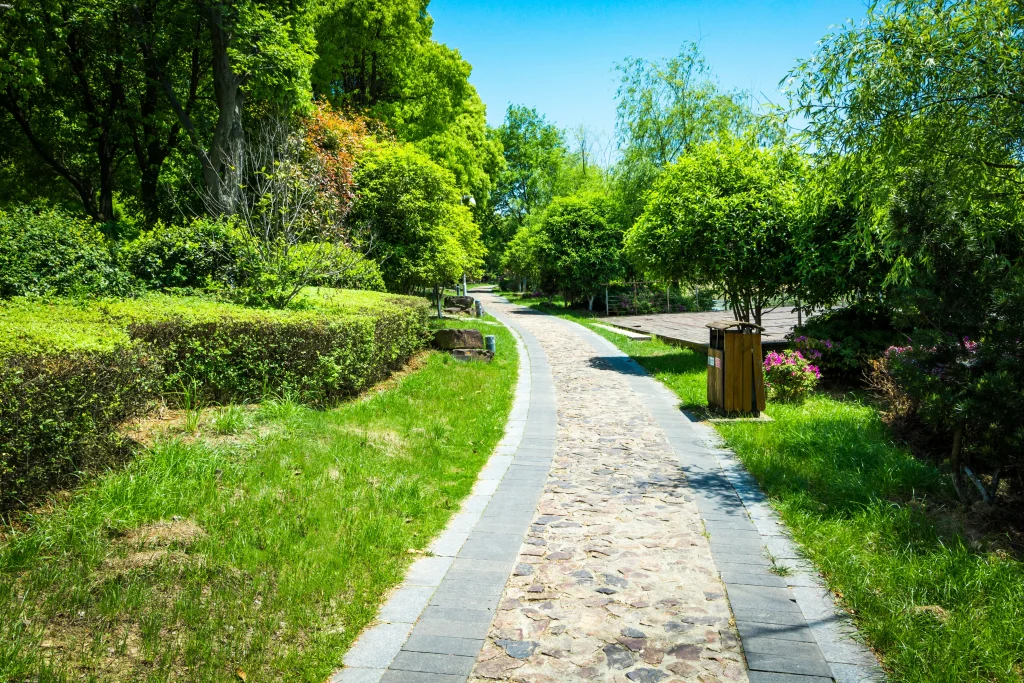River rock landscaping has become a cornerstone of Denver garden design. When you’re working with Colorado’s semi-arid climate, you need landscaping materials that can handle it all. River rocks deliver exactly that combination of durability and natural elegance.
In this comprehensive guide, we’ll walk you through 21 inspiring landscape designs with river rock tailored for Denver homes. You’ll discover how to select the right stone sizes and colors, and practical tips for installation and maintenance.
By the end, you’ll have everything you need to create a stunning, low-maintenance landscape with river rocks.

Benefits of using river rocks in Denver landscapes
Before diving into specific design ideas, let’s explore why river rocks have become such a popular choice for Denver homeowners who care about both aesthetics and functionality.
Aesthetic versatility
River rocks are flexible design elements. They complement modern minimalist homes with clean lines just as naturally as they enhance rustic mountain-style properties or traditional suburban gardens. The secret lies in their variety – you’ll find river rocks in soft grays and cool blues, warm tans and golds, striking black, and everything in between.
Low maintenance and exceptional longevity
Here’s where river rocks truly shine. While wood chips decompose and need replacement every 2-3 years, river rocks maintain their appearance indefinitely. They won’t attract termites or other pests, they resist Denver’s climate without breaking down.
Your maintenance routine becomes simple: an occasional leaf-blowing session, a yearly rinse, and periodic re-leveling after freeze-thaw cycles. That’s it. You’ll save hours of annual work outside.
Drainage and erosion control
River rocks excel at managing Denver’s rainfall. Their permeable nature allows water to filter naturally into the soil rather than running off, which reduces erosion and helps sustain your plants during dry periods.
For slopes, or areas prone to washout, river rock installations provide structural stability while maintaining natural aesthetics. A well-designed dry creek bed using river rocks can channel roof runoff away from your foundation and create an attractive landscape feature.
Eco-friendly and sustainable
River rocks are 100% natural. They’re harvested, cleaned, and ready to use. This makes them an excellent choice for environmentally conscious homeowners who prioritize sustainability.
Even better, river rock landscaping aligns with Denver’s water conservation initiatives and xeriscape principles. By replacing thirsty turf grass with rock and drought-tolerant plants, you can reduce your outdoor water consumption by 50-60%.
21 landscape design with river rock for Denver homes
Now let’s explore specific ways you can incorporate river rock into your Denver landscape.
Front yard river rock curb appeal
Create an inviting entrance by replacing traditional lawn areas with mixed-size river rock beds.
Start with a base layer of 2-3″ stones, then add visual interest with strategically placed larger rocks (6-10″) as focal points.
Integrate native ornamental grasses like Little Bluestem or Blue Fescue, which add softness and movement while thriving in Denver’s conditions.
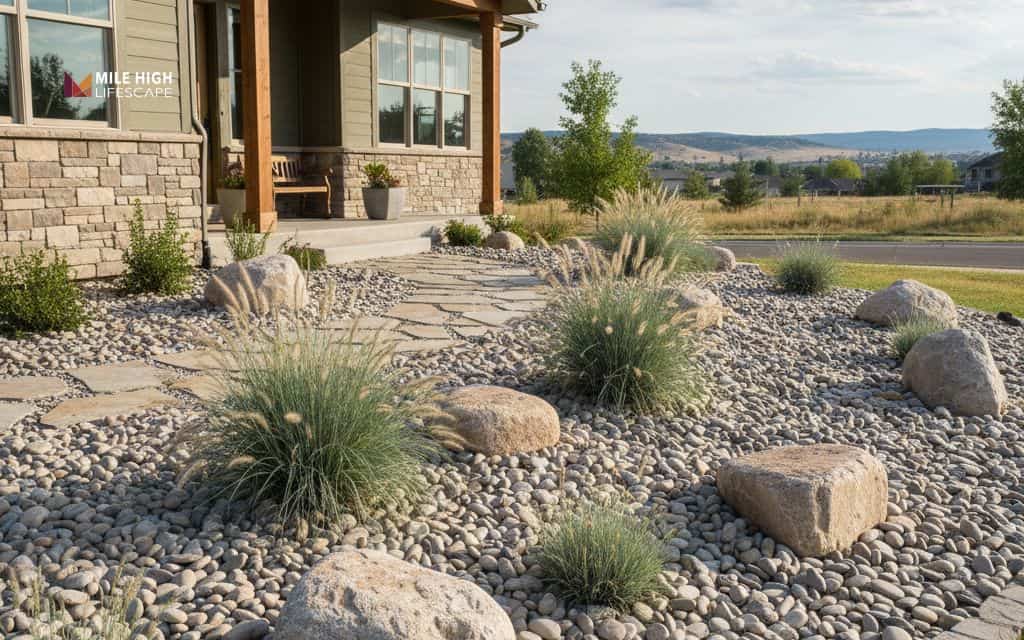
Xeriscape river rock garden
This is perhaps the most practical application to reduce water use.
Remove sections of turf grass and replace them with drought-tolerant plant clusters surrounded by river rock mulch. Choose plants with varying heights and textures.
The rocks serve triple duty: they suppress weeds, retain soil moisture by reducing evaporation, and create clean visual definition between plant groupings. Install drip irrigation beneath the rocks for maximum water efficiency.
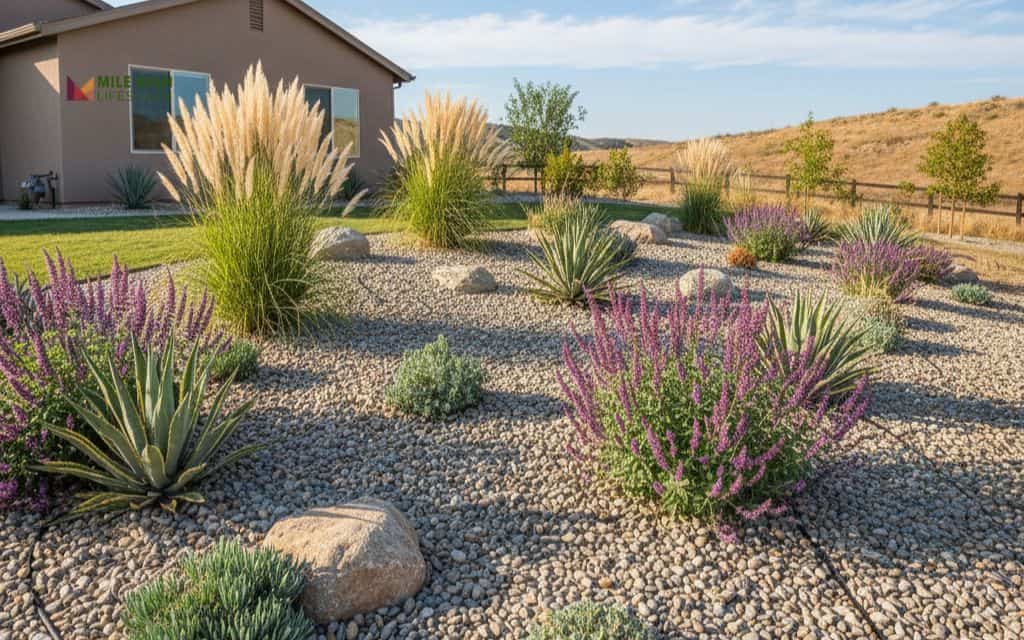
Dry creek bed for drainage
One of the most functional and attractive solutions for Denver’s storm water management challenges. Design a meandering channel using larger river rocks (4-8″) along the center to mimic a natural stream bed, with smaller stones (1-3″) along the edges. Plant native grasses and perennials along the banks for naturalistic appeal.
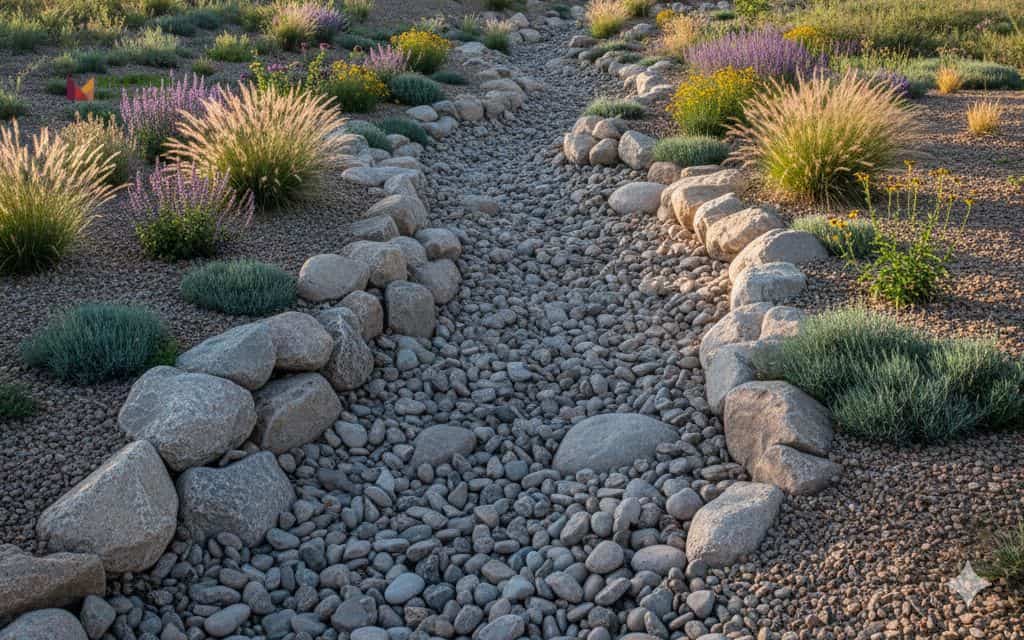
River rock flower bed borders
Storms can wash mulch right out of flower beds, leaving bare soil and displaced plants.
Create a protective barrier by edging your beds with a 4-6″ border of small river rocks (1-2″ size). These stay in place during heavy rain while providing crisp definition between lawn and planting areas.
The rocks also prevent grass from creeping into beds – a common frustration where aggressive grass varieties like Kentucky Bluegrass can invade adjacent areas.
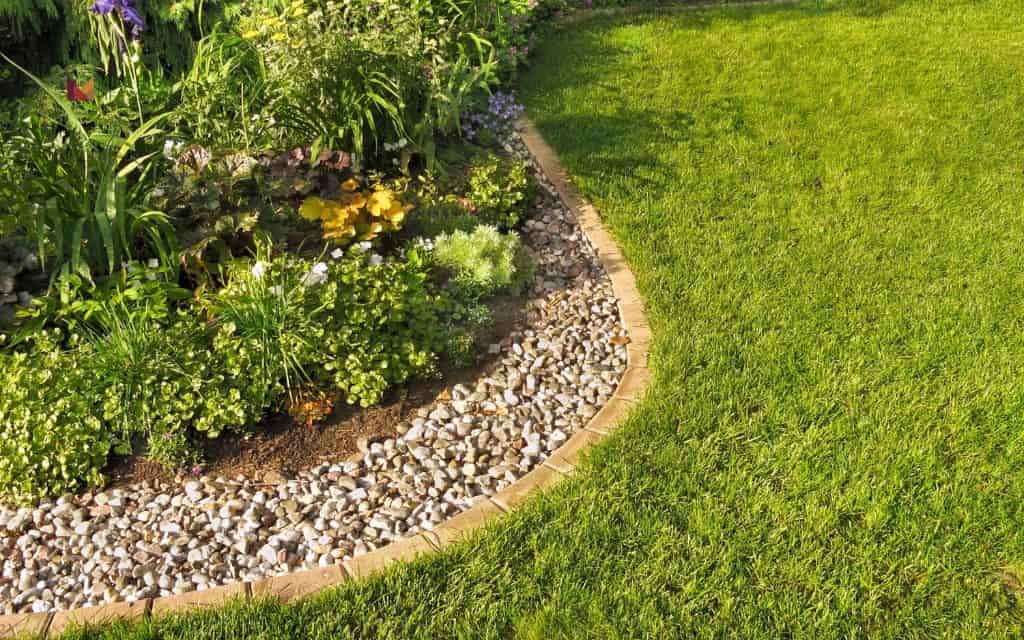
Decorative rock island with native plants
Transform a barren section of your yard into a focal point by creating an island bed. Arrange larger decorative boulders as anchors, then surround them with river rock mulch and colorful native perennials. This technique works in both front and back yards, adding dimension to flat spaces.
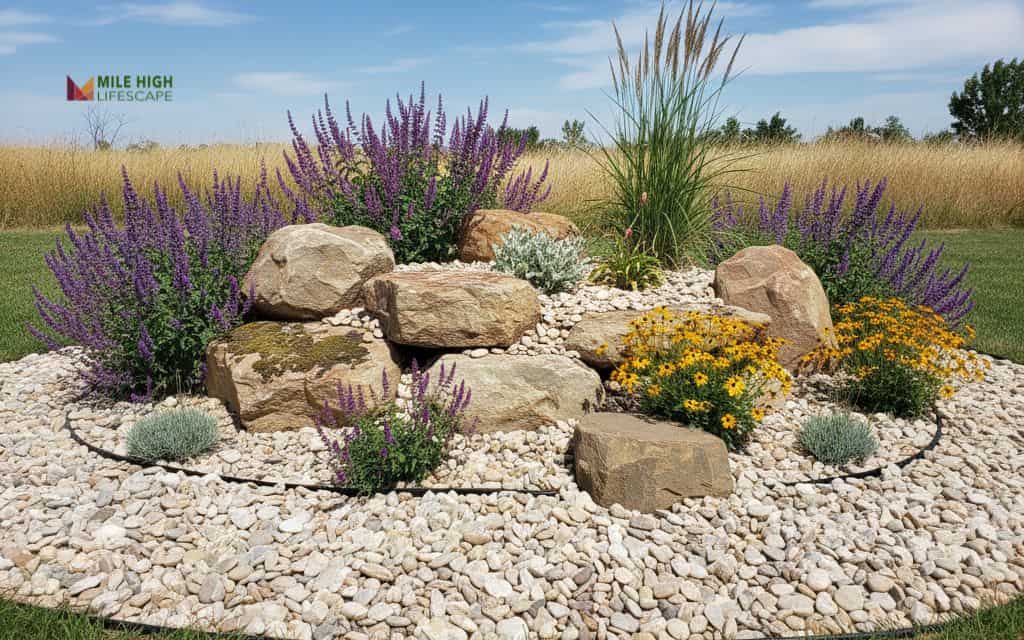
Southwest-inspired desert design
Embrace Colorado’s natural affinity with the American Southwest by combining warm-toned river rocks (tan, buff, and red) with desert plants. Yucca, Agave, and Opuntia (prickly pear cactus) all thrive in Denver’s climate and create dramatic sculptural interest against smooth river rock backgrounds.
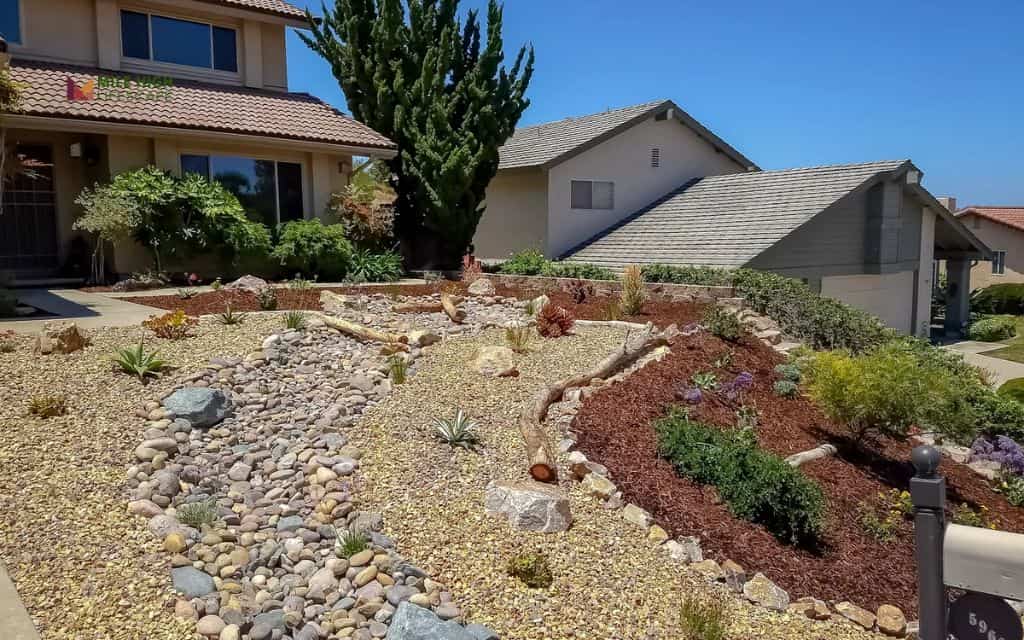
Modern river rock pathway
For contemporary homes, create sleek pathways using uniform-sized gray river rocks (2-3″) with metal or composite edging. Keep the lines geometric and intentional rather than meandering. The monochromatic color palette and clean edges complement modern architecture while providing a permeable walking surface.

Boulder and river rock composition
Position 2-4 large boulders as primary focal points – choose specimens with interesting shapes or colors – then surround them with river rock mulch in complementary tones. The size contrast creates visual drama while the combination feels authentically Colorado. Tuck alpine perennials like Columbine or Penstemon into the spaces between rocks for seasonal color.

Fire pit zone with heat-resistant stones
River rocks make excellent ground cover around fire pits and outdoor seating areas. Choose darker stones (gray or charcoal) that won’t show ash stains, and ensure they’re properly rounded river rocks rather than crushed stones – sharp edges become uncomfortable underfoot around seating areas.

Lighting accents with river rock bases
Landscape lighting creates ambiance and safety, but exposed fixtures and wiring look unfinished. Conceal the mechanics by surrounding path lights, uplights, and spotlight bases with decorative river rock. The stones hide hardware while their varied surfaces create interesting shadow patterns when illuminated.
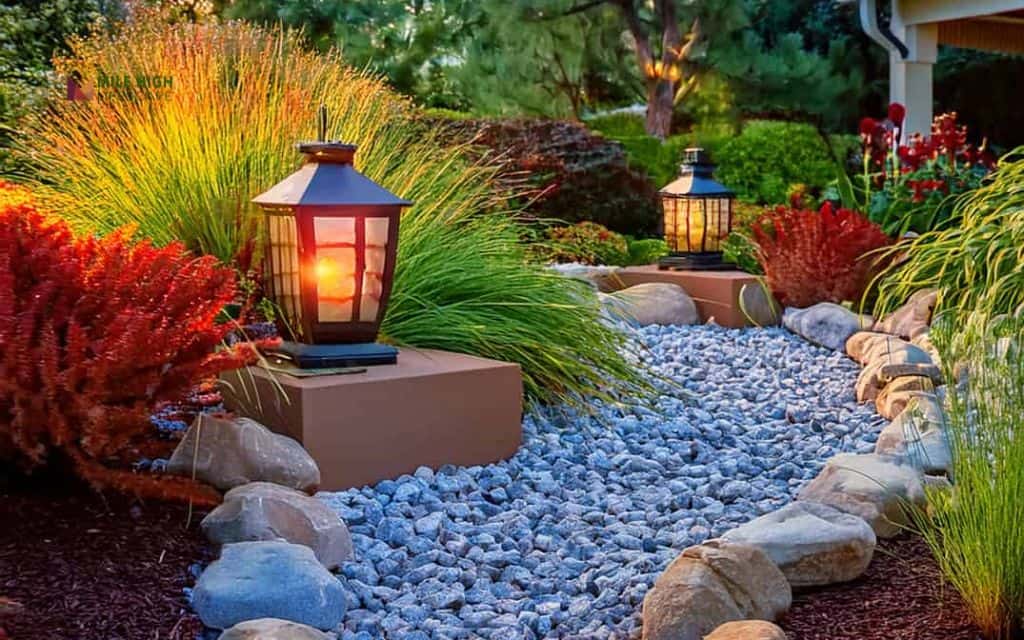
Rock-and-mulch contrast bed
You don’t have to choose between river rock and organic mulch, just combine them for visual interest and functional benefits. Use organic mulch around moisture-loving plants, then transition to river rock for borders and accent areas. The textural contrast adds depth and allows you to customize moisture retention for different plant needs.
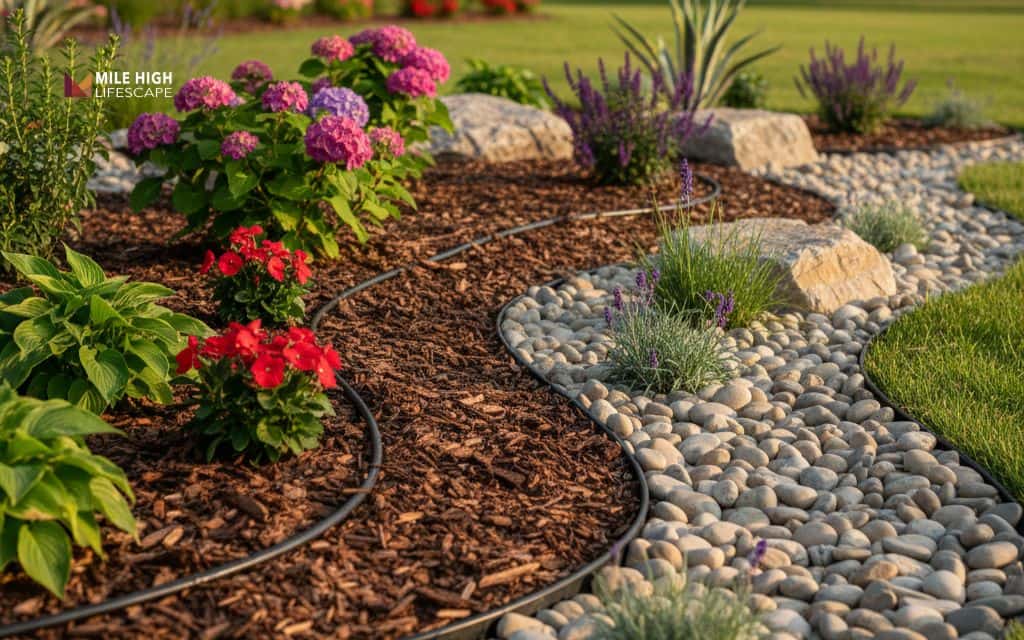
Tree base rock ring
Protect tree trunks from mower damage by creating a 2-3 foot diameter ring of river rock around the base. This eliminates the need for grass trimming near trunks and prevents the moisture-trap issues that can occur with bark mulch piled against tree bark.
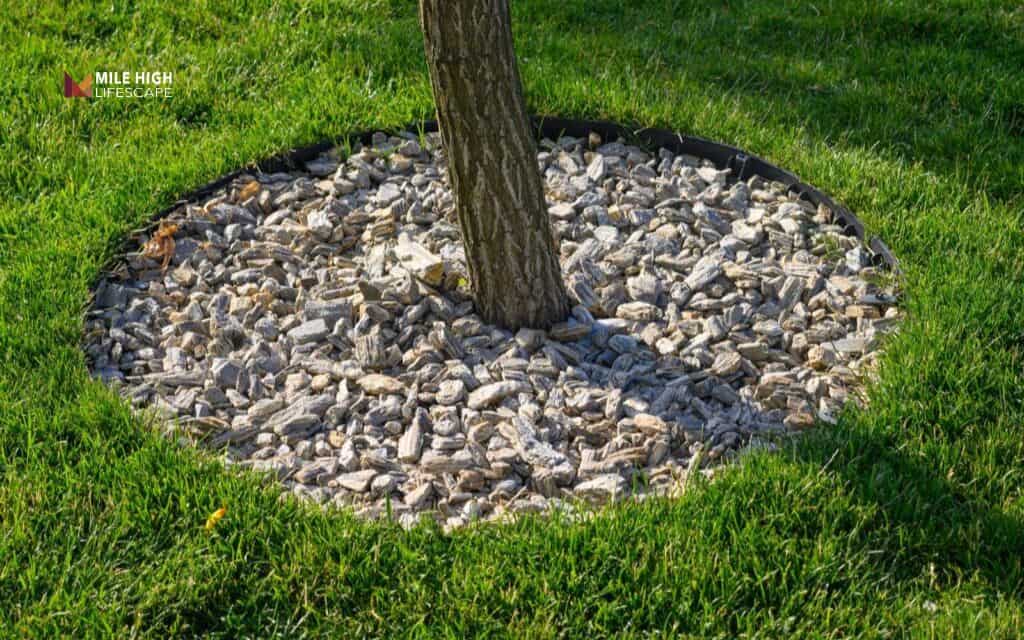
Minimalist river rock entry
Create impact through restraint by using monochromatic river rock – pure white, charcoal black, or uniform gray – as the primary ground cover near your entrance. Limit plantings to one or two dramatic specimen plants like ornamental grasses or sculptural Yucca.
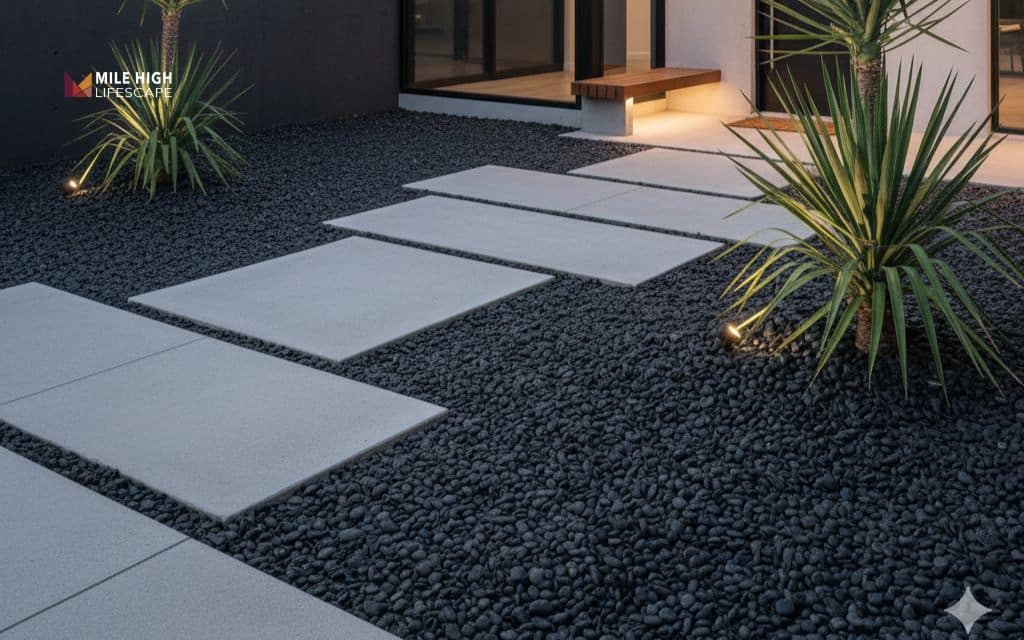
Backyard water feature
Whether you’re installing a pond, fountain, or pondless waterfall, river rocks provide the perfect naturalistic edging. Layer different sizes – larger rocks for structural edges, medium rocks for transition zones, and small pebbles for shallow areas where water meets land.
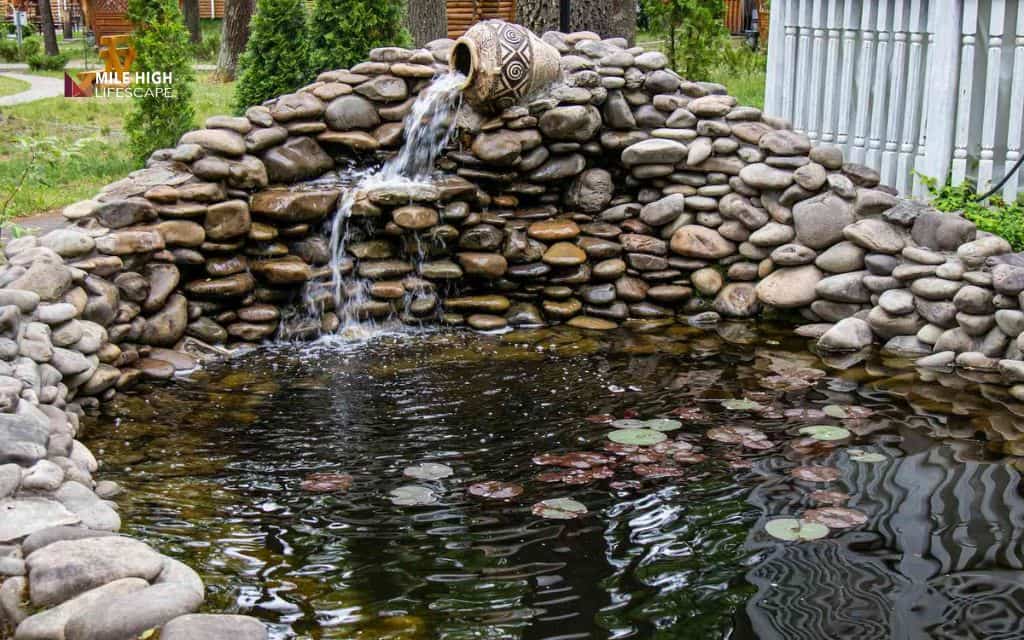
Side yard drainage path
The narrow side yards between houses often become problem areas for water accumulation and drainage.
Transform these challenging spaces into functional drainage corridors using river rock. Create a slight grade toward the street or back yard, then fill the pathway with 3-5″ river rocks over landscape fabric.
This solution directs gutter runoff away from foundations and maintains a clean appearance in an otherwise overlooked space.
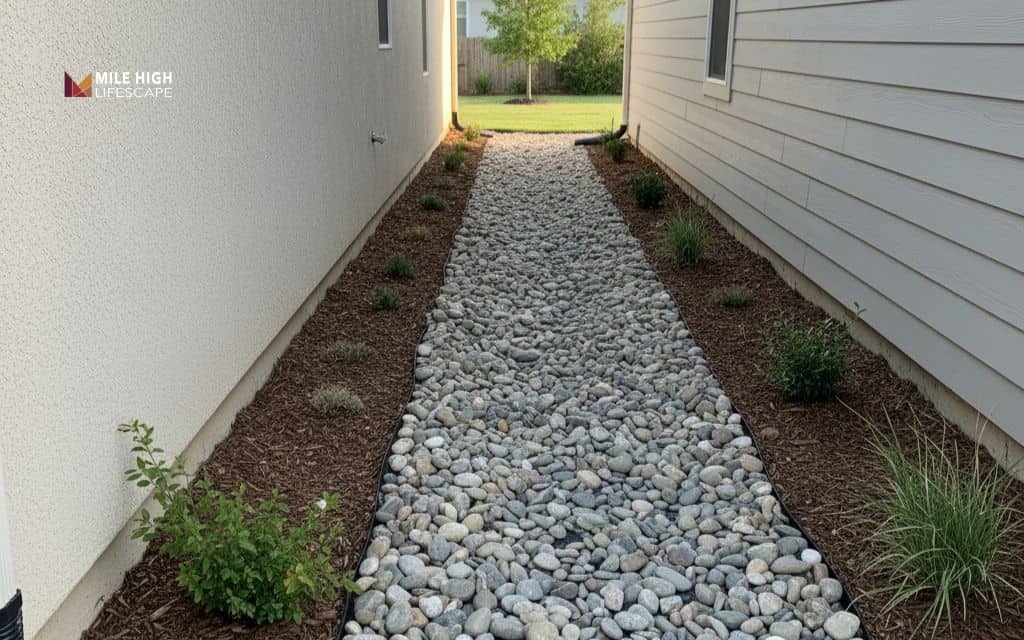
Pollinator-friendly rock garden
Support pollinator populations by creating sunny rock garden areas planted with native flowering perennials. The rocks provide thermal mass that warms quickly in spring sun while the flowers offer nectar and pollen through multiple seasons.
Choose natives like Penstemon, Blanket Flower, Catmint, and Salvia, which bees, butterflies, and hummingbirds have evolved to utilize.
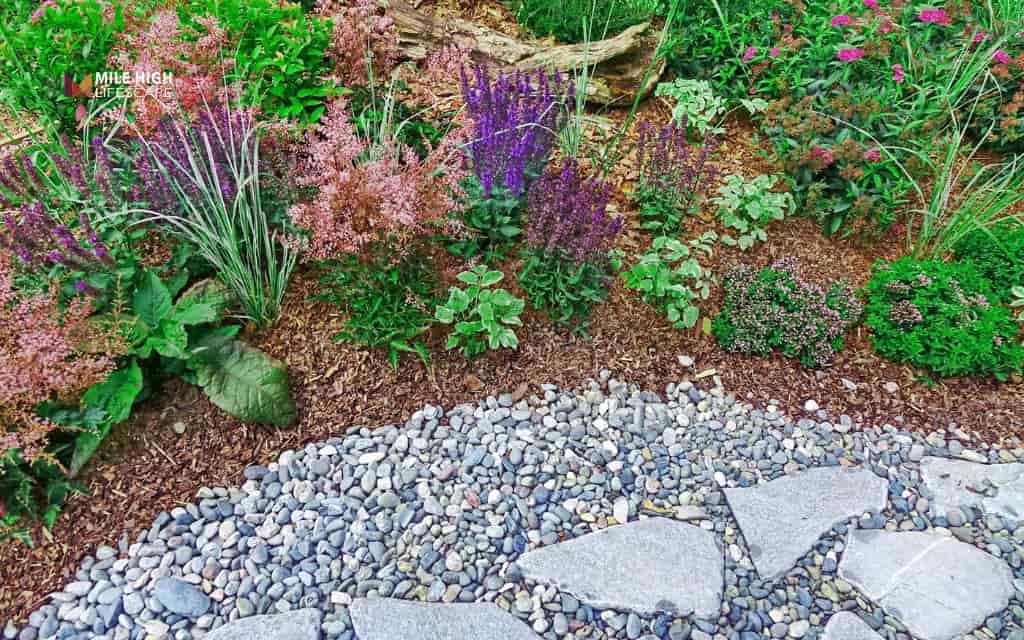
Raised river rock planter
Build elevation into flat yards by constructing raised planters with stacked stone walls, then filling them with river rock mulch around your plantings.
The vertical element creates visual interest, improving drainage which is valuable for plants that struggle in clay soils. Raised beds also extend your growing season by warming faster in spring and maintaining heat longer into fall.
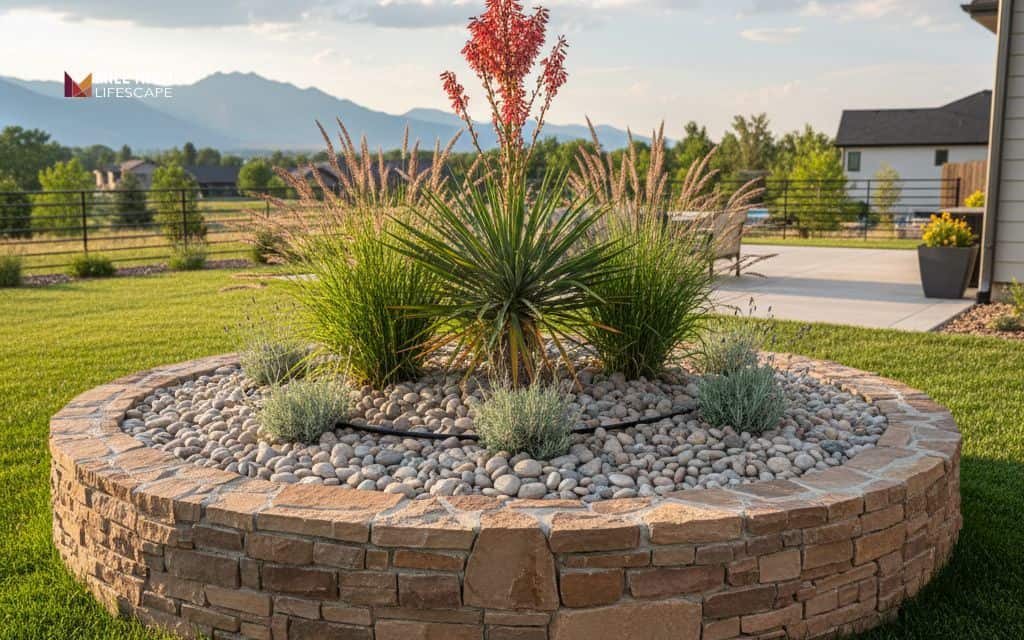
Under-deck or patio base
The ground beneath decks and covered patios often becomes muddy, weedy, or pest-attracting.
Solve these issues by covering the area with landscape fabric topped with 3-4″ of river rock. This creates a clean, dry surface that prevents mud splash-back onto your home’s siding while discouraging rodents and insects from nesting.
The rock also reflects light upward, making covered spaces feel brighter.
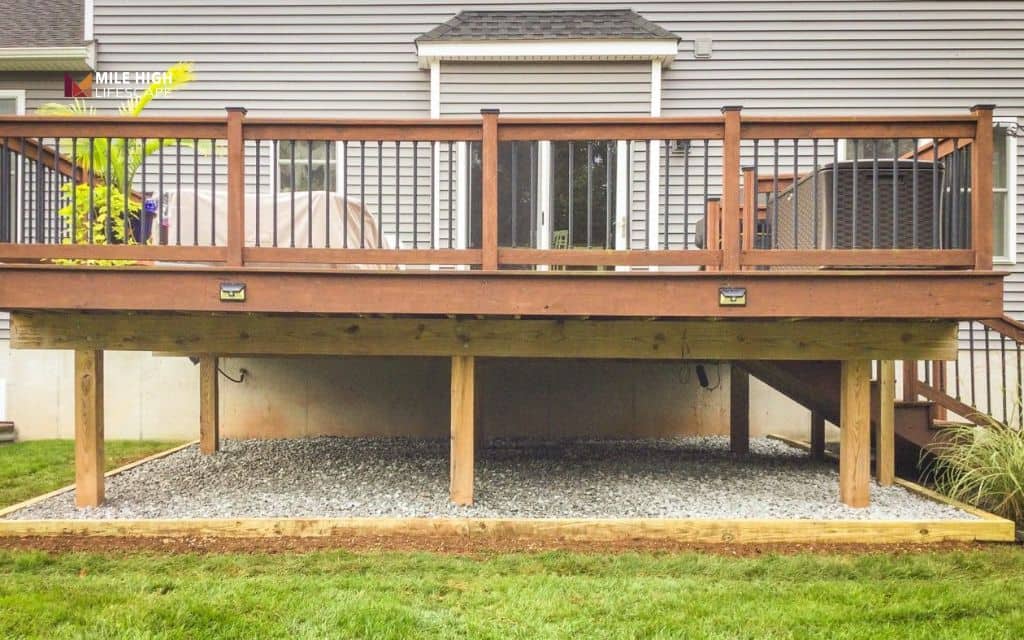
Sun-facing succulent bed
For those sunny exposures that challenge most plants, embrace the heat by creating a succulent garden with light-colored river rock mulch.
Tan and buff-colored rocks reflect rather than absorb solar radiation, moderating soil temperatures while creating the fast-draining conditions succulents require.
Plant Hens-and-Chicks, Sedum varieties, and Agave for a tapestry of textures that thrives on neglect – ideal for Denver’s water-conscious gardeners.
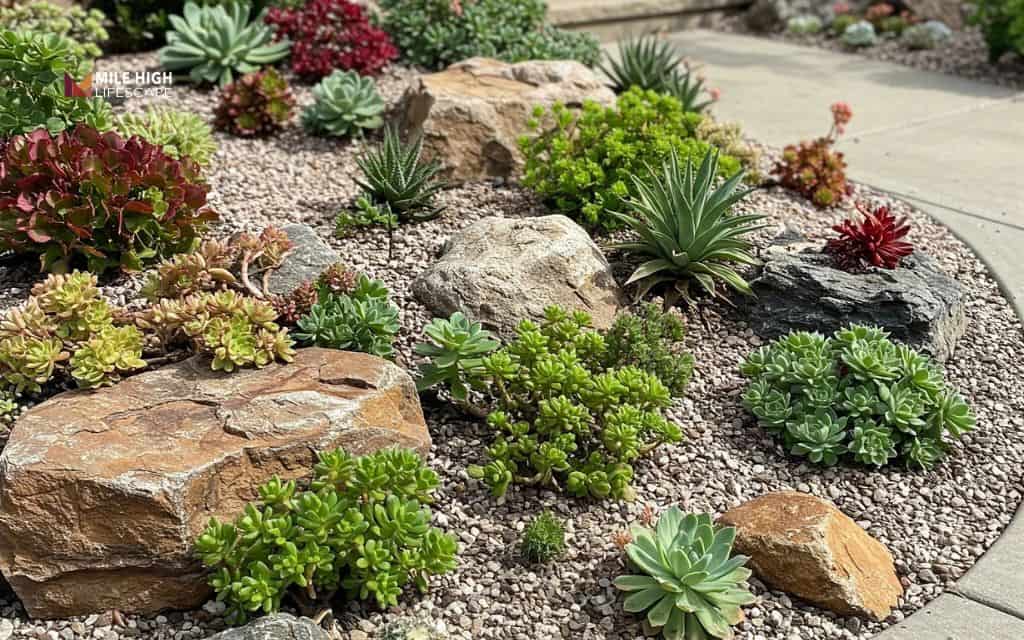
Driveway or walkway edging
Define the boundaries between hardscapes and landscape beds with 4-6″ wide strips of 3-5″ river rock. These borders prevent erosion at pavement edges while creating visual clarity and preventing grass from creeping onto driveways and walks.
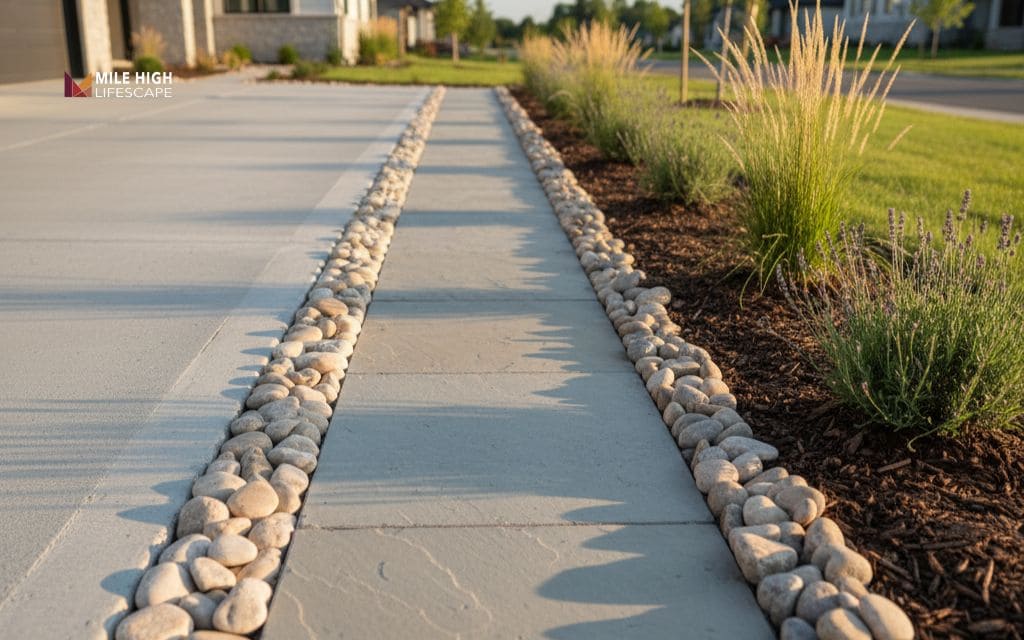
Alpine-inspired rockscape
Bring the beauty of Colorado’s high country to your yard by recreating an alpine environment. Use a mix of river rock sizes – from small pebbles to larger cobbles – arranged in natural-looking patterns that suggest mountain streams. Integrate native alpine plants like Columbine, alpine Penstemon, and native grasses.
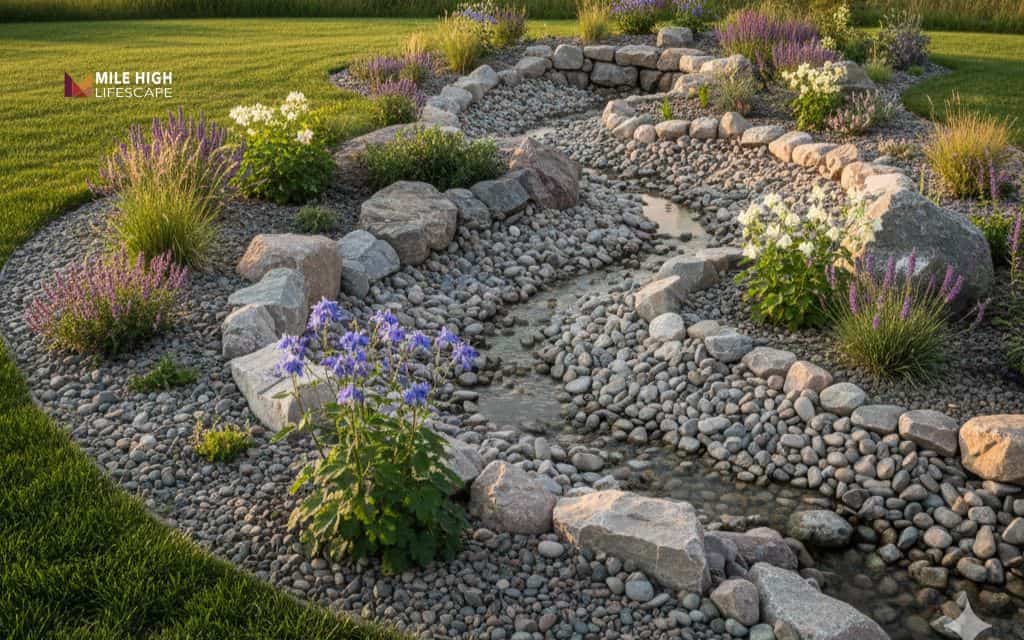
How to choose the right river rocks
Selecting appropriate river rock involves more than picking a color you like. Consider these factors to ensure your choice functions well in climate while achieving your aesthetic goals.
Match rock size to function
Different applications require different stone sizes for optimal performance:
- ½–1″ (Small pebbles): Best for flower bed borders and decorative accents. These smaller stones create cohesive surfaces but can migrate during heavy weather, so they need good edging.
- 1–3″ (Medium river rock): Ideal for pathways, general garden beds, and drainage applications. Heavy enough to resist wind and moderate runoff.
- 3–5″ (Large river rock): Excellent for accent areas, slopes, and transitional zones. The additional weight keeps stones in place during snowmelt and thunderstorms.
- 6–10″ (Cobbles and small boulders): Best for dry creek beds, major drainage channels, and structural features. These stay anchored during even the heaviest rainfall events Denver experiences.
Choose colors that complement your home
River rocks come in an impressive color range, and your selection should harmonize with your home’s exterior:
- Gray and blue tones: These cool colors pair beautifully with modern homes, brick exteriors, and properties with stone accents.
- Buff, tan, and gold tones: These warm earth tones complement stucco finishes, rustic mountain-style homes, and traditional architecture.
- Black and charcoal: Ideal for bold, minimalist designs and contemporary homes. These dramatic colors create a striking contrast against green plantings.
Balance texture and shape
The surface texture and shape of river rocks significantly impact both aesthetics and function:
- Rounded, smooth stones: These create the classic river rock appearance – soft, natural, and organic. They’re comfortable underfoot for pathways and seating areas, and their smooth surfaces shed water efficiently.
- Crushed or angular stones: While not technically “river rock,” crushed granite or angular stones offer a more contemporary, structured aesthetic. They lock together better than rounded stones, making them superior for high-traffic pathways.
- Mixed approach: Combining both rounded and angular rocks in a single landscape adds visual complexity and mimics natural environments. This approach works well in alpine-inspired designs.
Consider material weight and stability
- Heavier stones (3″ and larger): These resist displacement from wind, water, and freeze-thaw movement. They’re essential for slopes, drainage channels, and areas where erosion control is a priority.
- Lighter pebbles (under 1″): These create refined appearances but can scatter during heavy weather events. If you love the look of small pebbles, install edging or create a border trench to keep them contained.
- Installation strategy: Use edging materials like metal landscape edging, mortared stone borders, or even buried 2×4 treated lumber borders to create physical barriers that prevent rock migration. This is important in Denver, where spring runoff can be substantial after heavy snow winters.

Maintenance tips for long-lasting river rock landscapes
One of river rock’s greatest advantages is low maintenance requirements, but these simple practices will keep your landscape looking its best for decades:
- Monthly debris removal: Use a leaf blower to clear fallen leaves, seed pods, and organic debris from rock surfaces. This prevents decomposing material from creating soil pockets where weeds can establish.
- Annual rinsing: Once yearly, typically in early spring, rinse your river rocks with a strong garden hose spray to remove accumulated dust and restore their natural color and shine.
- Periodic refreshing: Every 5-7 years, you may want to add a thin top layer of fresh river rock to maintain optimal appearance and coverage. Over time, some smaller rocks will settle deeper into the soil, and adding a new surface layer restores visual impact.
- Weed prevention: Even with proper installation over landscape fabric, occasional weeds may appear. Address them when small rather than allowing them to establish. Hand-pulling is usually sufficient, and it’s far easier than in traditional mulched beds where roots intertwine with organic matter.
Conclusion
River rock landscaping offers Denver homeowners a practical solution that combines natural beauty with water conservation.
From xeriscape gardens to modern minimalist designs, the 21 landscape designs with river rock we’ve covered provide flexible options for any property style. With thoughtful planning and proper installation, your river rock landscape will provide decades of low-maintenance beauty while celebrating the natural character of Rocky Mountain living.
________________
Your Denver river rock landscape experts
For nearly two decades, Mile High Lifescape has been Denver’s trusted provider of professional landscaping rock services. We handle everything from design to installation – xeriscape gardens, dry creek beds, river rock pathways, decorative borders, native plantings, and drainage solutions built for Colorado conditions.
Ready to transform your garden with professional river rock landscaping?
Call Mile High Lifescape: (303) 877-9091
Frequently asked questions (FAQs)
What size river rock works best for landscaping?
1-3″ river rock is the most versatile size for landscapes. It works well for beds, borders, and pathways while being heavy enough to resist wind and moderate runoff. For slopes or heavy drainage areas, use 3-5″ rocks for better stability.
Does river rock make my yard hotter?
River rock does retain some heat, but the effect depends on color. Light-colored rocks (tan, white, buff) reflect heat and stay cooler, while dark rocks (black, charcoal) absorb more. Strategic placement and plant shading help manage temperature in high-use areas.
How deep should river rock be laid?
Lay 2-3″ deep for standard garden beds and borders. Use 4″ depth for drainage areas, dry creek beds, or erosion control zones. Always install over landscape fabric for weed prevention.
Is river rock eco-friendly?
Yes. River rock is a natural material requiring no chemical treatments. It supports water conservation by reducing evaporation and eliminating frequent irrigation needs. Since it lasts 20-30+ years, it produces no waste compared to mulch that needs replacing every 2-3 years.
What are the disadvantages of river rock landscaping?
Higher upfront cost (2-3x more than mulch initially), no soil nutrient contribution, and small rocks (under 2″) may shift in windy areas. However, long-term savings on water, maintenance, and replacement costs typically offset the initial investment within 5-7 years.
What looks good with river rock?
Native Colorado plants like ornamental grasses (Blue Fescue, Little Bluestem), drought-tolerant perennials (Penstemon, Blanket Flower, Salvia), succulents (Sedum, Hens-and-Chicks), and architectural plants (Yucca, Agave). Combine with larger boulders, flagstone, or steel edging for added visual interest.
What do you put under river rock for landscaping?
Always use landscape fabric (4-6 oz weight minimum) to prevent weed growth while allowing drainage. Remove existing vegetation, level the area, install any needed irrigation, then lay fabric with 6-8″ overlaps at seams before adding rocks.
